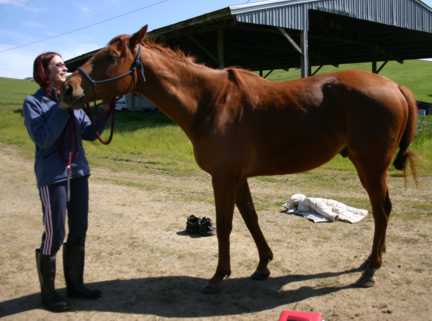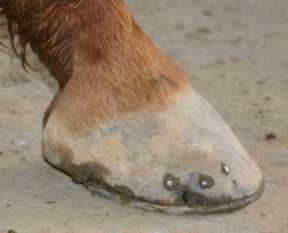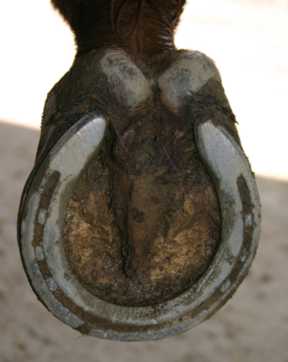 |
HealthyHoof.comHoofcare & Information for Barefoot SoundnessLinda Cowles Hoof Care - Serving the greater SF Bay Area and Northern California |
Lucas
|
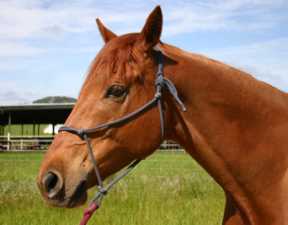 |
|||
|
||||
I met 8 year old Lucas and his owner, Katja, a few weeks before we pulled his shoes. His last set of shoes had been on for several weeks, he had adequate sole maturity and wall growth to safely remove his shoes and Katja said he was "moving normally". I like to carefully watch horses move before and after pulling shoes and after the first trim, and I usually watch horses move before and after subsequent trims. Why? Because my job is to improve a horses soundness.Katja and I decided to let shoe removal wait a few weeks because his soles were thin and flat even though they looked mature. Lucas always landed toe-first in shoes, and inspection of his shoes revealed a wear pattern that indicated that he used his heels as lightly as possible. Katja remarked that fragile Lucas' feet were usually tender for a week after re shoeing, and that he typically was unsound following any change in farrier's. I took a deep breath and crossed my fingers that we could keep him comfortable through the first few weeks. |
||||
We knew Lucas was going to be a tough horse to transition to barefoot, but I was confident we could get him at least as sound barefoot as he was in shoes, and perhaps much sounder. Tough transitions take time and commitment on the owners part, plus an investment in transition / rehab boots when we expect that a horse will be tender. Katja had the 100% commitment it takes to make a transition happen; she was determined to reverse his history of unsoundness. Katja eagerly bought one type of boots for day and night use in his paddock and stall (Soft Rides), and another type for riding and real exercise (Easy Care Epics). I carefully explained that because Lucas had sensitive feet and he was typically tender after shoeing, he may be tender for as much as a month, even with the boots. Katja took a deep breath and said "The money is nothing at this point, I want him comfortable and happy for many years, so let's try. His feet are getting steadily worse in the shoes, he regularly loses a shoe every two weeks, so I have to try something else. He's still young and we have no other good alternative. " Katja adores Lucas and explained that she was childless "except for Lucas", who was her very expensive baby. Expensive? You bet... She had fallen in love with Lucas in Florida, where she bought him as a 4 year old off the track TB without knowing he was only marginally sound, and she has been paying vets and farrier's a hefty fee every few weeks ever since to keep him going. Lucas's physical ailments aren't limited to his feet; he and Katja no longer live in Florida because Lucas has a condition where he can't sweat in that climate. He has a very bad front left knee that occasionally lays him up for a week or two. But he has a heart of gold and tons of character, and is a perfect pet when he's too unsound to be anything more. |
||||
Lucas and Katja 1 month after starting his barefoot transition. Note his Soft Ride boots in the background |
||||
Most owners in Katja's situation are initially very skeptical about barefoot. They feel desperate for a "cure" but have been warned about attempting barefoot by well-meaning vets and farrier's. These owners spend a great deal of time investigating potential ways of helping their horses, and after researching alternatives are willing to take a chance on barefoot because it offers the promise of long term soundness even when most vets and farrier's would tell them that their horse could never be a candidate. |
||||
Tough Transitions Take Client CommitmentRemoving the shoes from an already unsound horse is extremely stressful for owners who love their horses. They fear for their horses lives, and most vets don't recommend removing the shoes from an already tender horse. They usually recommend the opposite, applying bar shoes, pads and wedges. The fact that these owners are trying something that their vets and farrier's consider to be "radical" makes them feel foolish and risky, they spend nights lying awake thinking about unasked questions and worrying that they may not have double checked the horses boots. They feel pressured by other horse owners to keep trying traditional hoof care - shoes with pads and wedges - even though it hasn't worked in the past. The only reason most of them try barefoot is because their instincts tell them it should work, and they are frustrated by failed attempts with assorted shoeing therapies. They worry about having to prematurely have to put their beloved horses to sleep. How do I know this? I once owned a horse like this... my sweet Cammie, an off the track appy with horrible feet. Barefoot Miracles?The thought of being able to provide comfort or actual soundness to a chronically unsound horse by applying a "natural" treatment is a strong motivation ... I know this better than most folks! The possibility of "curing" an unsound horse by attempting to return their feet to a natural state is so compelling for me that I choose to add rehab clients to my list when they are considerably harder to work with physically and emotionally, are much riskier from a business perspective, and they take 40% more time because of the amount of focus, documentation, client education and support required. I do whatever it takes to help these horses and their owners because I understand how vulnerable their position is. I've been able to help many of these Lucas type horses in a short period of time, but need to stress that barefoot isn't the great cure-all for every horse. Many horses feet are crippled by years of imbalance, so sometimes all we can achieve is an improved level of comfort. I do believe that barefoot transitions can help most horses, so I continue to photograph every transition, and struggle to find the time and energy to document the most notable cases. I question every trim, worry about wall length, heel height and frog condition, call clients after most trims, trying to find out how it affected their horse. Crossing my fingers that my instincts were correct. This work is hard physically and emotionally. I encourage my clients to investigate every option that appears to have merit and remember to discuss it during our trims. They are active partners in my "Transition Team", observing changes, learning to watch a horse move to identify sources of unsoundness. I need them to be my functioning partner.
Below, Katja and Lucas at his new pasture home in May and June of 2006, three and four months after pulling his shoes. |
||||
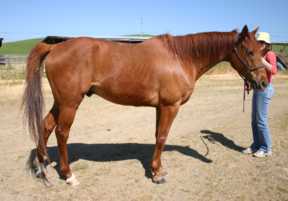 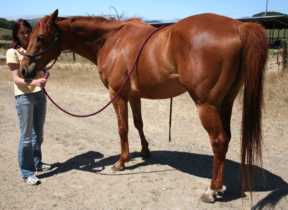 |
||||
Serving the greater SF Bay Area & Northern California
Home | Contact Linda | Privacy | About Us
